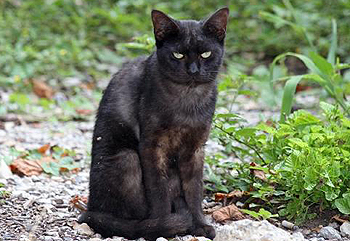


FERAL
CATS
Identification
The cat has been the most resistant to change of all
the animals that humans have domesticated. All members of the cat family,
wild or domesticated, have a broad, stubby skull, similar facial characteristics,
lithe, stealthy movements, retractable claws (except the cheetah),
and nocturnal habits.
Feral cats are house cats living in the wild. They are small
in stature, weighing from 3 to 8 pounds (1.4 to 3.6 kg), standing 8
to 12 inches (20 to 30.5 cm) high at the shoulder, and 14 to 24 inches
(35.5 to 61 cm) long. The tail adds another 8 to 12 inches (20 to 30.5
cm) to their length. Colors range from black to white to orange, and
an amazing variety of combinations in between. Other hair characteristics
also vary greatly.
Range
Cats are found in commensal relationships wherever people are found.
In some urban and suburban areas, cat populations equal human populations.
In many suburban and eastern rural areas, feral house cats are the
most abundant predators.
Habitat
Feral cats prefer areas in and around human habitation. They use
abandoned buildings, barns, haystacks, post piles, junked cars, brush
piles, weedy areas, culverts, and other places that provide cover and
protection.
Food Habits
Feral cats are opportunistic predators and scavengers that
feed on rodents, rabbits, shrews, moles, birds, insects, reptiles, amphibians,
fish, carrion, garbage, vegetation, and leftover pet food.
General Biology, Reproduction, and Behavior
Feral cats produce 2 to 10
kittens during any month of the year. An adult female may produce 3 litters
per year where food and habitat are sufficient. Cats may be active during
the day but typically are more active during twilight or night. House
cats live up to 27 years. Feral cats, however, probably average only
3 to 5 years. They are territorial and move within a home range of roughly
1.5 square miles (4 km2). After several generations, feral cats can be
considered to be totally wild in habits and temperament.
Damage
Feral cats feed extensively on songbirds, game birds, mice and
other rodents, rabbits, and other wildlife. In doing so, they lower the
carrying capacity of an area for native predators such as foxes, raccoons,
coyotes, bobcats, weasels, and other animals that compete for the same
food base.
Where documented, their impact on wildlife populations in suburban and rural areas (directly by predation and indirectly by competition for food) appears enormous. A study under way at the University of Wisconsin (Coleman and Temple 1989) may provide some indication of the extent of their impact in the United States as compared to that in the United Kingdom, where Britain's five million house cats may take an annual toll of some 70 million animals and birds (Churcher and Lawton 1987). Feral cats occasionally kill poultry and injure house cats.
Feral cats serve as a reservoir for human and wildlife diseases, including
cat scratch fever, distemper, histoplasmosis, leptospirosis, mumps,
plague, rabies, ringworm, salmonellosis, toxoplasmosis, tularemia,
and various endo- and ectoparasites.
Legal Status
Cats are considered personal property if ownership can be
established through collars, registration tags, tattoos, brands, or legal
description and proof of ownership. Cats without identification are considered
feral and are rarely protected under state law. They become the property
of the landowner upon whose land they exist. Municipal and county animal
control agencies, humane animal shelters, and various other public
and private "pet" management agencies exist because of feral or unwanted
house cats and dogs. These agencies destroy millions of stray cats
annually.
State, county, and municipal laws related to cats vary. Before lethal control is undertaken, consult local laws. If live capture is desired, consult the local animal control agency for instructions on disposal of cats.
Bats Birds Chipmunks Feral Cats Mice Opossums Raccoons Skunks Snakes Squirrels Woodchucks

